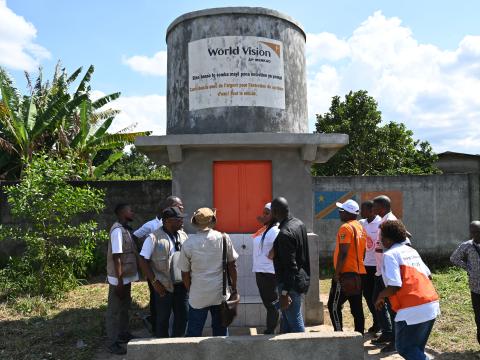DR Congo: Menkao and Maluku: Between Hope and Challenges for Access to Safe Drinking Water

By Didier Nagifi, Communications Officer
From May 7 to 8, 2025, a joint delegation from World Vision DRC and the Ministry of Water Resources conducted a field mission in the localities of Menkao and Maluku to assess the progress of WASH (Water, Sanitation, and Hygiene) infrastructure and identify ongoing challenges in access to safe drinking water.
Menkao: A Developing Network with Promising Prospects
In Menkao, the teams visited a facility that includes a captured water source, a 22 kW solar-powered pump, storage tanks, a public kiosk, and a network powered by solar panels. This system is designed to serve up to 35,000 residents.
“We came to witness the project’s progress, which is crucial for this community. However, challenges remain. That’s why we called upon the ministry’s experts to optimize the network and reach 90% of the population,” said Aline Napon, National Director of World Vision DRC.
Justin Leonard, Head of the Division for Hydraulic Infrastructure Monitoring at the ministry, praised the technical efforts while emphasizing the need for a long-term vision:
“The infrastructure developed in Menkao is impressive. Seeing these modern facilities built to meet the needs of thousands is a significant step forward for the community. However, it is vital to anticipate risks, especially erosion that could compromise the structures. All relevant authorities must be involved to ensure the sustainability of this system.”
For his part, Paterne Aksante, WASH Programme Manager, highlighted the importance of the existing installations: “Thanks to the solar pump and the 60 m³ tank, we have the capacity to significantly improve the supply of safe drinking water. However, we need to stabilize the network so it operates efficiently and without interruption.”
Maluku: A Mobilized Community and Tangible Progress
The visit continued in Maluku, where the water supply has significantly improved thanks to two reservoirs of 90 m³ and 110 m³, more than 30 standpipes, and the installation of solar panels powering a submersible pump. This pump enables water to be transported to the reservoirs, ensuring continuous supply.
“Water is transforming the lives of Maluku’s residents. Some adjustments are still needed to ensure regular distribution,” added Aline Napon.
Justin Leonard emphasized the remarkable involvement of the residents: “In Maluku, we witnessed exemplary local mobilization. The community management of the network and maintenance of the infrastructure show that the population is taking ownership of the project. However, it is essential to strengthen this dynamic by establishing appropriate policies and better regulation.”
Paterne Aksante also commended the active participation of the beneficiaries: “The residents are investing their own resources to maintain and expand the network. The installation of the submersible pump enhances the system’s reliability, but technical monitoring is still needed to ensure its performance.”
Eugénie, a member of the local water management committee, shared the project’s social impact: “Thanks to the income generated from water, we support children’s education, help the elderly, and respond to emergencies. This infrastructure is essential for our development.”
The Children’s Appeal from Menkao
During the visit, children from the community voiced their hopes with urgency:
“We want to see water flowing here! If water doesn’t come out, we won’t let World Vision leave!”
A direct call reflecting a vital need and growing awareness of water-related issues.
Towards a Sustainable and Replicable Model
The experiences of Menkao and Maluku illustrate both the significant progress made possible through institutional and community partnerships and the remaining technical and organizational challenges. They demonstrate that, through effective community management and sustainable investments, access to safe drinking water can become a reality for thousands of Congolese, contributing to the economic and social development of these localities.